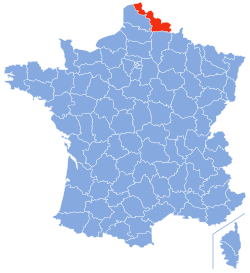Nord (département)
| Nord | ||
|---|---|---|
| Department | ||

Prefecture building of the Nord department, in Lille
|
||
|
||
 Location of Nord in France |
||
| Coordinates: 50°23′N 03°19′E / 50.383°N 3.317°ECoordinates: 50°23′N 03°19′E / 50.383°N 3.317°E | ||
| Country | France | |
| Region | Hauts-de-France | |
| Prefecture | Lille | |
| Subprefectures |
Avesnes- sur-Helpe Cambrai Douai Dunkirk Valenciennes |
|
| Government | ||
| • President of the General Council | Patrick Kanner | |
| Area | ||
| • Total | 5,742.74 km2 (2,217.28 sq mi) | |
| Population (1 Jan 2013) | ||
| • Total | 2,595,536 | |
| • Rank | 1st | |
| • Density | 450/km2 (1,200/sq mi) | |
| Time zone | CET (UTC+1) | |
| • Summer (DST) | CEST (UTC+2) | |
| Department number | 59 | |
| Arrondissements | 6 | |
| Cantons | 41 | |
| Communes | 648 | |
| ^1 French Land Register data, which exclude estuaries, and lakes, ponds, and glaciers larger than 1 km2 | ||
Nord (French pronunciation: [nɔʁ]; English: North; Dutch: Noorderdepartement) is a department in the far north of France. It was created from the western halves of the historical counties of Flanders and Hainaut, and the Bishopric of Cambrai. The modern coat of arms was inherited from the County of Flanders.
Nord is the country's most populous department. It also contains the metropolitan region of Lille, the fifth-largest urban area in France after Paris, Lyon, Marseille, and Toulouse. Within the department is located the part of France where the French Flemish dialect of Dutch is still spoken (along with French) as a native language.
Nord was one of the original 83 departments that were created during the French Revolution on 4 March 1790. It was made up of three regions: parts of the Counties of Flanders and Hainaut, and the Bishopric of Cambrai, which were ceded to France in successive treaties (1659, 1668, and 1678).
During the 4th and 5th centuries, the Roman practice of coopting Germanic tribes to provide military and defense services along the route from Boulogne to Cologne created a Germanic-Romance linguistic border in the region that persisted until the 8th century. Saxon colonization into the region from the 5th to the 8th centuries likely extended the linguistic border somewhat south so that by the 9th century most inhabitants north of Lille spoke a dialect of Old Dutch, while the inhabitants to the south spoke a variety of Romance dialects.
...
Wikipedia

